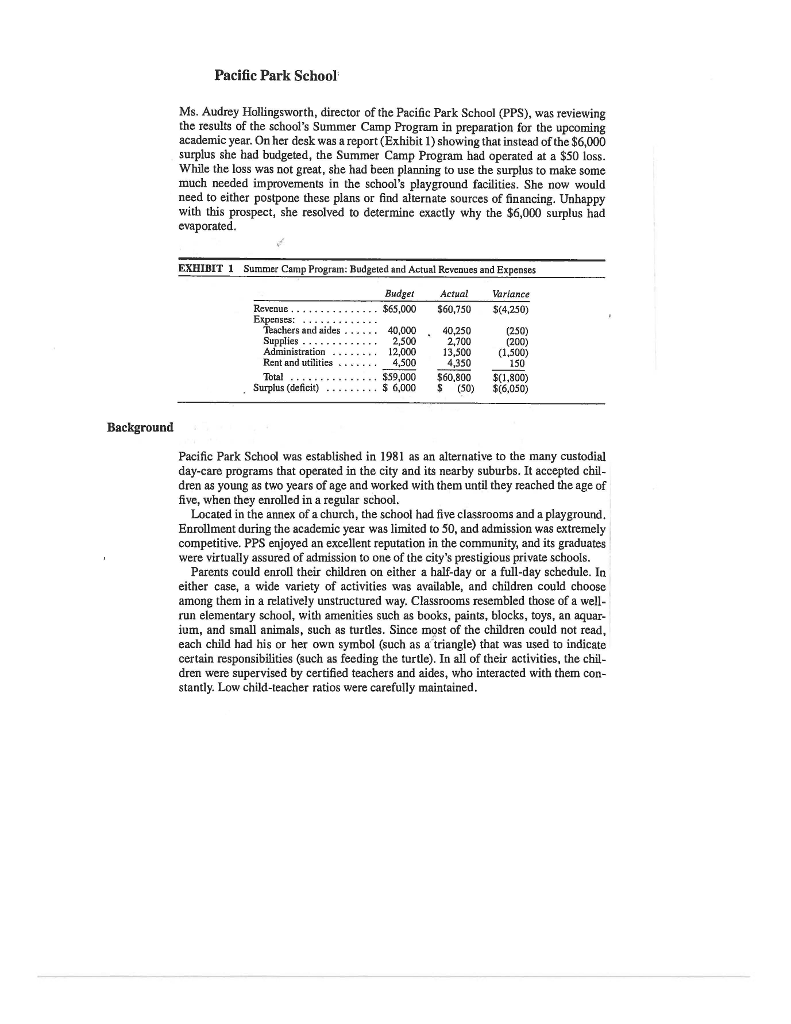

Pacific Park School Ms. Audrey Hollingsworth, director of the Pacific Park School (PPS), was reviewing the results of the school's Summer Camp Program in preparation for the u academic year. On her desk was areport (Exhibit 1) showing that instead of the $6,000 surplus she had budgeted, the Summer Camp Program had operated at a $50 loss. While the loss was not great, she had been planning to use the surplus to make some much needed improvements in the school's playground facilities. She now would need to either postpone these plans or find alternate sources of financing. Unhappy with this prospect, she resolved to determine exactly why the $6,000 surplus had evaporated. pcoming EXHIBIT 1 Summer Camp Program: Budgeted and Actual Reve?ues and Expenses Budget Variance $65,0000,750 $(4,250) Actual Expenses Teachers and aides . Supplies Administration Rent and utilities . . Total (250) (200) .12,000 13,500 1,500) 40,00040,250 2,700 2,500 4,500 4,350 $59,000 $60,800 $(1,800) $6,000 (50) $(6,050) Surplus (deficit) Background Pacific Park School was established in 1981 as an alternative to the many custodial day-care programs that operated in the city and its nearby suburbs. It accepted chil dren as young as two years of age and worked with them until they reached the age of five, when they enrolled in a regular school. Located in the annex of a church, the school had five classrooms and a playground Enrollment during the academic year was limited to 50, and admission was extremely competitive. PPS enjoyed an excellent reputation in the community, and its graduates were virtually assured of admission to one of the city's prestigious private schools. Parents could enroll their children on either a half-day or a full-day schedule. In either case, a wide variety of activities was available, and children could choose among them in a relatively unstructured way. Classrooms resembled those of a well run elementary school, with amenities such as books, paints, blocks, toys, an aquar- ium, and small animals, such as turtles. Since most of the children could not read each child had his or her own symbol (such as a triangle) that was used to indicate certain responsibilities (such as feeding the turtle). In all of their activities, the chil dren were supervised by certified teachers and aides, who interacted with them con stantly. Low child-teacher ratios were carefully maintained Pacific Park School Ms. Audrey Hollingsworth, director of the Pacific Park School (PPS), was reviewing the results of the school's Summer Camp Program in preparation for the u academic year. On her desk was areport (Exhibit 1) showing that instead of the $6,000 surplus she had budgeted, the Summer Camp Program had operated at a $50 loss. While the loss was not great, she had been planning to use the surplus to make some much needed improvements in the school's playground facilities. She now would need to either postpone these plans or find alternate sources of financing. Unhappy with this prospect, she resolved to determine exactly why the $6,000 surplus had evaporated. pcoming EXHIBIT 1 Summer Camp Program: Budgeted and Actual Reve?ues and Expenses Budget Variance $65,0000,750 $(4,250) Actual Expenses Teachers and aides . Supplies Administration Rent and utilities . . Total (250) (200) .12,000 13,500 1,500) 40,00040,250 2,700 2,500 4,500 4,350 $59,000 $60,800 $(1,800) $6,000 (50) $(6,050) Surplus (deficit) Background Pacific Park School was established in 1981 as an alternative to the many custodial day-care programs that operated in the city and its nearby suburbs. It accepted chil dren as young as two years of age and worked with them until they reached the age of five, when they enrolled in a regular school. Located in the annex of a church, the school had five classrooms and a playground Enrollment during the academic year was limited to 50, and admission was extremely competitive. PPS enjoyed an excellent reputation in the community, and its graduates were virtually assured of admission to one of the city's prestigious private schools. Parents could enroll their children on either a half-day or a full-day schedule. In either case, a wide variety of activities was available, and children could choose among them in a relatively unstructured way. Classrooms resembled those of a well run elementary school, with amenities such as books, paints, blocks, toys, an aquar- ium, and small animals, such as turtles. Since most of the children could not read each child had his or her own symbol (such as a triangle) that was used to indicate certain responsibilities (such as feeding the turtle). In all of their activities, the chil dren were supervised by certified teachers and aides, who interacted with them con stantly. Low child-teacher ratios were carefully maintained








